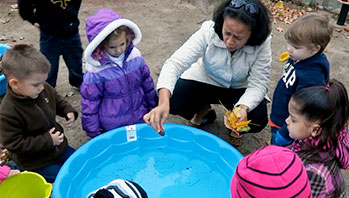- camera
- magnifying lenses
- pail
- trowels
- trays
- grow
- plant
- soil
- underground
- worm
MA Standards
English Language Arts/Language/L.PK.MA.6: Use words and phrases acquired through conversations, listening to books read aloud, activities, and play.
MA Draft Standards
Life Sciences/Ecosystems; Biological Evolution/LS2/4.C: Investigate local environments and infer/imagine how some living things might meet basic needs. [Structure and Function; Cause and Effect]
Life Sciences/Ecosystems; Biological Evolution/LS2/4.D: Determine the variety of living things in a local area and characteristics of the places where they were found.
Life Sciences/From Molecules to Organisms: Inheritance and Variation of Traits/LS1/3.A: Describe/draw and compare the body parts of animals (including themselves) and plants they are investigating [System] and explain functions of some of the observable body parts. [Structure and Function]
Head Start Outcomes
Logic and Reasoning/Reasoning and Problem Solving: Classifies, compares, and contrasts objects, events, and experiences.
Science Knowledge/Scientific Skills and Method: Uses senses and tools, including technology, to gather information, investigate materials, and observe processes and relationships.
PreK Learning Guidelines:
English Language Arts/Language 2: Participate actively in discussions, listen to the ideas of others, and ask and answer relevant questions.
Science and Technology/Inquiry Skills: 3 Identify and use simple tools appropriately to extend observations.
Science and Technology/Living Things and Their Environment 15: Use their senses of sight, hearing, touch, smell, and taste to explore their environment using sensory vocabulary.
Explore Together (outdoors): Underground Environment

© Commonwealth of Massachusetts, Department of Early Education and Care. All rights reserved.
STEM Key Concepts: Plants get their needs met from the environment (their habitat); Some plant parts are below the ground and some above; Earthworms are animals that live in the soil, underground
ELA Focus Skills: Listening and Speaking, Vocabulary
Educator Prep: If children do not find a few worms in their exploration today, you may need to purchase (at a local bait store or pet store) or search for worms to continue the Small Group activity. Before the activity, go outside and find an area where children can safely dig small holes to look for worms and other living things underground.
Safety Tips:
- Be aware of and check for poison ivy and poison sumac before gathering children in a designated area.
- Remind children to wash their hands before and after the activity.
- Remind children not to eat ANY plants or touch any plants without asking an adult.
- Take children’s allergies into account before going outside.
Tell children you are going to take them outdoors to explore plants on the ground. Say, We are going outside to look in, around, and under the outdoor plants to see if we can find small animals that might help the plants grow. We are especially going to look for worms.
Take children outside to an area where they can dig holes in the ground. Once outside allow children to explore freely.
- Prompt children to place the soil they dig up on the trays so they can move it around, explore with their hands, and compare it to other children’s soil.
- Encourage children to use the magnifying lenses to look more closely at things in the soil that is either on the tray or in the hole.
- Have children collect things they want to share with others.
Circulate and listen for what children are observing. Ask, How does the soil change as you dig deeper? Encourage them to notice and describe any worms, insects, or other small animals they are finding by asking:
- What do you notice about its size, shape?
- What was it doing when you found it?
- How is it moving?
Focus children’s attention on the area where they are finding the worms by asking:
- How deep did you have to dig to find that worm?
- What other things do you notice in the area where the worm is?
- What do you notice about the soil?
Take photos or videos or their observations to use throughout the week.
Reflect and Share
Have children share what they observed while exploring. Share the pictures you took and have the trays of soil they collected so children can refer to them as they speak. Ask questions such as,
- What living things did you notice in, around, and under the plants? (roots, bugs, worms, seeds)
- How did the worm react when you first scooped the dirt off of it? Why do you think it did that?
- Why do you think worms like to be underground? Why is the dirt a good place for worms to live?
- Do you have any ideas about how worms might help plants?
Social Emotional Tip: Help children build confidence in their own ability, pride in work well done, and appreciation for the ability of others by having them work cooperatively in a group or with a partner.
Take It Further: You may want to acknowledge that worms are often on top of the ground after a rainstorm. Ask children why they think there are so many worms above ground after it rains.
Educator Tip: Be aware of children who show a dislike for worms. Do not force them to touch the worms, but encourage them to take part in other parts of the activity.
Adaptation: For groups with children with tactile sensitivities, you may want to have large spoons on hand so those children can join in the activity comfortably.
Adaptation: For groups with very young children, you may want to loosen the dirt so children will be able to scoop out a hole in the ground. You may need to work with children to dig a large enough hole for them to observe.
